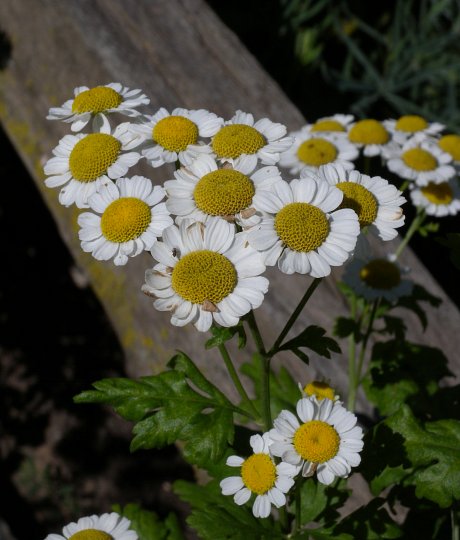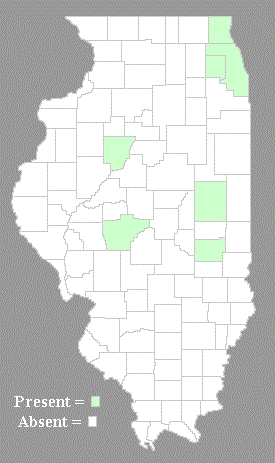
The upper stems terminate in flat-headed panicles of flowerheads. Each flowerhead spans about ¾–1" across, consisting of 10-20 ray florets that surround a dense central head of numerous disk florets. The central head is flat initially, but it later becomes dome-shaped. The petaloid rays are white, elliptic-oblong in shape, few-toothed at their tips, widely spreading, and relatively short. The corollas of the disk florets are about 2 mm. long, yellow, and narrowly cylindrical in shape with 4-5 upper lobes. The ray florets are pistillate (female), while the disk florets are perfect (both male and female). The saucer-shaped base of each flowerhead is surrounded by appressed floral bracts (phyllaries) in several series. These bracts are light green, lanceolate in shape, keeled, and usually canescent; the upper halves of their keels are a darker shade of green. The peduncles of the flowerheads are up to 4" long; they are similar to the upper stems in their characteristics. The blooming period occurs during the summer for 1-2 months, sometimes extending into
 early autumn. Afterwards,
fertile
florets are replaced by small achenes. These achenes are about 1.5 mm.
long, narrowly oblongoid in shape, longitudinally ribbed, and
tan-colored or brown-colored. At the apex of each achene, there is
often a crown of
minute scales. These achenes are light and small enough to be blown
about by the wind to some extent. The root system consists of a taproot
or caudex with abundant fibrous roots.
early autumn. Afterwards,
fertile
florets are replaced by small achenes. These achenes are about 1.5 mm.
long, narrowly oblongoid in shape, longitudinally ribbed, and
tan-colored or brown-colored. At the apex of each achene, there is
often a crown of
minute scales. These achenes are light and small enough to be blown
about by the wind to some extent. The root system consists of a taproot
or caudex with abundant fibrous roots.Cultivation: The preference is full or partial sun, more or less mesic conditions, and a fertile loamy soil. The lower leaves may turn yellow and wither away during hot dry spells.
Range & Habitat: Naturalized populations of Feverfew are widely scattered in the northern half of Illinois, where they are uncommon. Feverfew was introduced into North America from Eurasia as an ornamental and medicinal plant for gardens. It is probably native to SE Europe, Turkey, and the lower Caucasus mountains. In Illinois and other areas of North America, Feverfew can be found in such habitats as abandoned garden areas, vacant lots, roadsides, abandoned fields, and waste areas. Habitats with a history of disturbance are preferred.
Faunal Associations: Müller (1873/1883) observed a Sesiid moth, a Halictid bee, and a wasp visiting the flowerheads of Feverfew (Tanacetum parthenium) in Germany. Similar insects probably visit the flowerheads of this plant in North America. Both nectar and pollen are available as floral rewards for such visitors. Other insects feed on the leaves and other parts of Feverfew and similar plants in the Aster family. The larvae of a fly, Chromatomyia syngenesiae (Chrysanthemum Leafminer) mine the leaves of Feverfew (Needham et al., 1928). Other insects that probably feed on this plant include several aphids (Macrosiphoniella spp.); see Pepper (1965) and Blackman & Eastop (2013) for a description of these species. Because of the strong aroma and bitter flavor of the foliage, it is doubtful that mammalian herbivores make much use of this plant.
Photographic Location: A flower garden in Champaign-Urbana, Illinois.

Comments: The taxonomic history of Feverfew (Tanacetum parthenium) has been somewhat unstable. Other scientific names for this species in the past include Chrysanthemum parthenium and Matricaria parthenium. Feverfew is one of several plant species from Eurasia that have daisy-like flowerheads. Feverfew differs from many of these species by having leaves with wider leaflets and lobes. Compared to the central disks of its flowerheads, the petaloid rays are relatively short. The aromatic foliage of this plant is similar to the aroma of cultivated Chrysanthemums that bloom during the autumn. Feverfew has been considered a medicinal plant for some time. It has been used to reduce fever and inflammation, and also to treat migraine headaches. There is some scientific evidence that it is useful for some of these purposes, especially for treatment of migraine headaches (Palevitch et al., 1997).